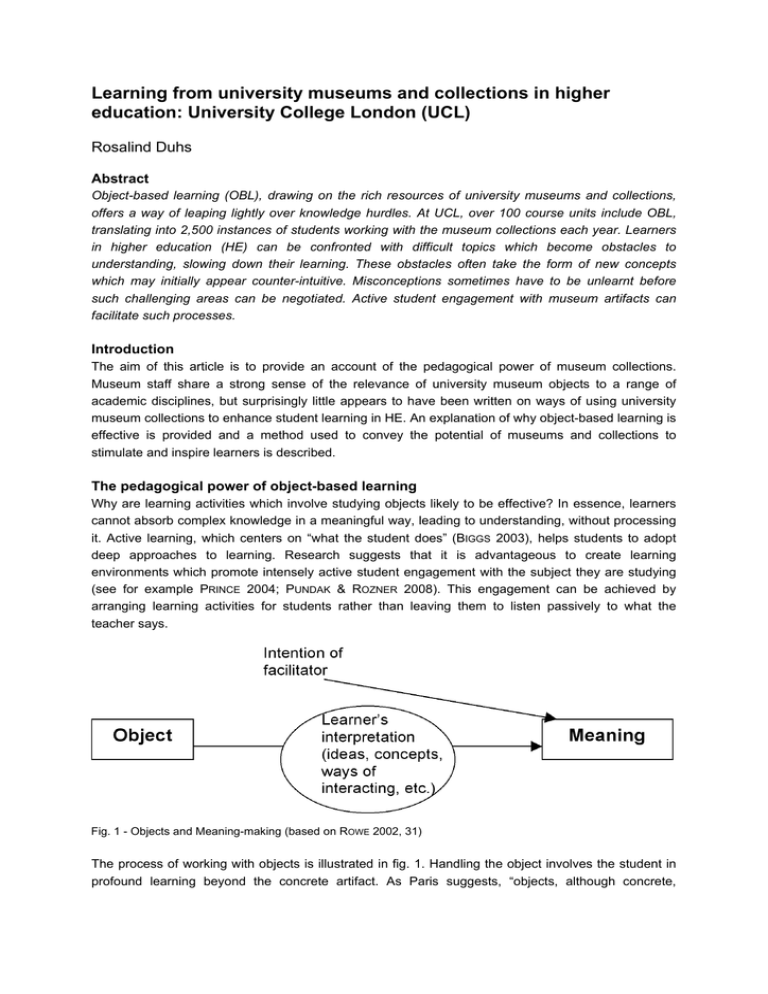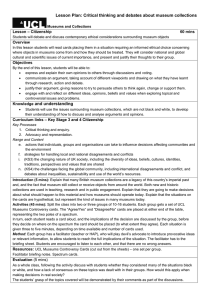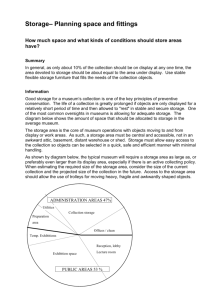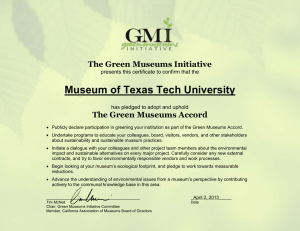Learning from university museums and collections in higher Rosalind Duhs
advertisement

Learning from university museums and collections in higher education: University College London (UCL) Rosalind Duhs Abstract Object-based learning (OBL), drawing on the rich resources of university museums and collections, offers a way of leaping lightly over knowledge hurdles. At UCL, over 100 course units include OBL, translating into 2,500 instances of students working with the museum collections each year. Learners in higher education (HE) can be confronted with difficult topics which become obstacles to understanding, slowing down their learning. These obstacles often take the form of new concepts which may initially appear counter-intuitive. Misconceptions sometimes have to be unlearnt before such challenging areas can be negotiated. Active student engagement with museum artifacts can facilitate such processes. Introduction The aim of this article is to provide an account of the pedagogical power of museum collections. Museum staff share a strong sense of the relevance of university museum objects to a range of academic disciplines, but surprisingly little appears to have been written on ways of using university museum collections to enhance student learning in HE. An explanation of why object-based learning is effective is provided and a method used to convey the potential of museums and collections to stimulate and inspire learners is described. The pedagogical power of object-based learning Why are learning activities which involve studying objects likely to be effective? In essence, learners cannot absorb complex knowledge in a meaningful way, leading to understanding, without processing it. Active learning, which centers on “what the student does” (BIGGS 2003), helps students to adopt deep approaches to learning. Research suggests that it is advantageous to create learning environments which promote intensely active student engagement with the subject they are studying (see for example PRINCE 2004; PUNDAK & ROZNER 2008). This engagement can be achieved by arranging learning activities for students rather than leaving them to listen passively to what the teacher says. Fig. 1 - Objects and Meaning-making (based on ROWE 2002, 31) The process of working with objects is illustrated in fig. 1. Handling the object involves the student in profound learning beyond the concrete artifact. As Paris suggests, “objects, although concrete, 184 · UMACJ 3/2010 actually represent a vast continuum of abstract ideas and inter-related realities” (2002, X). They therefore have the power to help students to cope with challenging aspects of the curriculum. Multiple sensory modes and learning Working with objects strengthens learning, as the sense of touch can lead to a more memorable learning experience. It has been established that “object-handling has a long-lasting effect and relationship with memory, more so than text-based learning often has” (ROMANEK & LYNCH 2008, 284). Biggs explains that “[The] more [teaching and learning activities] tie down the topic to be learned to multiple sensory modes, the better the learning” (2003, 80). Teachers can plan learning activities based on the study of museum artifacts so that they involve all five senses, enriching and deepening learning. Interaction with fellow learners can stimulate an interchange of ideas about the object and help groups to respond to testing questions through enquirybased learning exercises. Experiencing how artifacts enhance learning This example of how artifacts can support learning is based on a hands-on session for academic staff in HE and museum curators. The goal was to enable them to experience the impact of learning from objects first-hand. The theory underpinning the design of the session was adapted from Kolb’s (1984) experiential learning cycle, illustrated in fig. 2 (and see MARIE 2010). In this case, the application of Kolb’s model to the learning session involved participants in experiencing a hands-on activity (concrete experience, 1), making reflective observations on the experience (observation and reflection, 2), building abstract concepts from their reflections (forming abstract concepts, 3), and planning how they might test or apply these concepts in the context of a teaching activity (testing in new situations, 4). The experience was arranged using objects borrowed from the Grant Museum Fig. 2 - Kolb’s experiential learning cycle of Zoology at UCL. Observations about the learning which resulted from that experience were made in the groups which had handled the objects, and participants then had the opportunity to consider how object-based learning could be further expanded and integrated into the learning and teaching situations relevant to them. Negotiating ‘threshold concepts’ and ‘troublesome knowledge’ Meyer and Land’s work (2005) focuses on difficult areas of knowledge. When they are understood, they can lead to a shift in learners’ perception of a subject. They are so significant that they are unlikely to be forgotten, and they also reveal how apparently disparate aspects of a subject are actually interrelated. The acquisition of these transformative, irreversible, and integrative aspects of knowledge can be facilitated by studying artifacts. OBL can help learners through the borderline or liminal states which precede understanding. When they have negotiated threshold concepts, learners may extend their language, and develop further professionally, acquiring the identity of their discipline. They will have taken another step towards becoming biologists, art historians or archaeologists, for example. An illustration of phylogeny, the evolution of genetically related groups of organisms, was selected to show how object handling can be used to support learning. Five groups of conference delegates Learning from university museums and collections · 185 focused on the evolution of the mammalian skull. They studied the skulls of primates. The first task was to identify the objects. It was not too challenging to guess that all were skulls, but not so easy to guess that they came from primates. Delegates were then asked to brainstorm on three characteristics of the primate skull which distinguish it from a reptilian skull. The experience of viewing, holding and closely examining the skulls engendered a sense of excitement in the lecture theatre. The groups were invited to report on the results of the brainstorming session. They did remarkably well in identifying the relevant features of the skulls. These included: the single jawbone, the two lumps on the bone where the spine enters the brain, and the mammal’s differentiated teeth. All these features could be observed and inspected on the sample skulls, reinforcing learning Fig. 3 - A mammalian skull: the four-horned antelope © UCL Grant Museum of Zoology visually, through touch, and through communication with colleagues. Reptiles, in contrast, have seven-part jawbones, a single bump where the spine enters the brain, and only one type of tooth, essentially for stabbing. Completing Kolb’s experiential learning cycle Phase 1 of Kolb’s experiential learning cycle had been completed. Phase 2, reflection and observation, was a consideration of the learning process. It had involved listening, speaking, looking, and touching. The groups had interacted and been thoroughly drawn into the learning process by the requirement to study the objects and brainstorm. Phase 3, forming abstract concepts, was facilitated by the provision of an outline of the advantages of OBL as a form of active learning. Finally, in phase 4, proposals for testing OBL in new situations were made. The following steps were suggested when planning OBL sessions. If learners are involved in this process, and can select an activity from a choice of options, they will feel highly motivated, which aids learning. First, a ‘threshold concept’ to be negotiated is selected. Objects which might help to support that learning are sought out. Learners are asked to speak or write about their current knowledge of the concept or topic. This is important, as misconceptions can be identified and cleared up. Preparation for engagement with the object should be detailed. Students may need to read texts or study images so that they can benefit fully from the time they spend working with the object. The learning activities which are to be completed also need to be carefully designed. The aim will be to encourage close observation, discussion, and reflection through learning activities based around the object. Students could be required to write their own question sheets to complete or these could be supplied by the teacher. Sketches, not for the quality of the drawing, but to aid close attention to the artifact, may be made. 186 · UMACJ 3/2010 Follow-up activities are also useful. Virtual images of the artifact can be helpful, and additional reading, writing and oral work may be done to consolidate learning. Assessment tasks can be carried out using related or similar artifacts. Assessment has a strong influence on learning and traditional timed written examinations may lead to last-minute cramming. A flexible exploration of student understanding using museum objects can take place on several occasions during a course of study. Students can be invited to engage in a dialogue with an examiner based on an artifact. Attention to the learning outcomes which are being tested is essential. If a careful marking scheme is prepared, student performance can be evaluated relatively easily. Conclusion Artifacts offer learners in HE the opportunity to engage with exciting learning which goes beyond the study of the object itself, facilitating the understanding of challenging concepts. Teachers need to plan OBL and its assessment with care, but the time invested will be worthwhile. Once prepared, activities can be re-used with different groups of learners. Based on our experience at UCL, we believe that enriching learning will result. Literature cited BIGGS, J. 2003. Teaching for quality learning at University. 2nd ed. Buckingham: The Society for Research into Higher Education & Open University Press. KOLB, D. A. 1984. Experiential learning: Experience as the source of learning and development. Englewood Cliffs, N. J.: Prentice-Hall, Inc. MARIE, J. 2010. The role of object-based learning in transferable skills development. University Museums and Collections Journal 3, 187–190. MEYER, J. H. F. & R. LAND 2005. Threshold concepts and troublesome knowledge (2): Epistemological considerations and a conceptual framework for teaching and learning. Higher Education 49, 3: 373–388. PARIS, S. G. 2002. Perspectives on object-centered learning in museums. Mahwah NJ: Lawrence Erlbaum Associates. PRINCE, M. 2004. Does active learning work? A review of the research. Journal of Engineering Education 93, 3: 223–231. PUNDAK, D. & S. ROZNER 2008. Empowering engineering college staff to adopt active learning methods. Journal of Science Education and Technology 17, 2: 152–163. ROMANEK, D. & B. LYNCH 2008. Touch and the value of object handling: Final conclusions for a new sensory museology. In: Touch in museums: Policy and practice in object handling, ed. H. J. CHATTERJEE (Oxford: Berg), 275–286. ROWE, S. 2002. The role of objects in active, distributed meaning-making. In: Perspectives on objectcentered learning in museums, ed. S. G. PARIS (Mahwah, N. J.: Lawrence Erlbaum Associates), 19– 36. Contact Dr Rosalind Duhs Senior Teaching Fellow Address: Centre for the Advancement of Learning and Teaching (CALT), University College London, 119 Torrington Place, London WC1E 7HB, UK E-mail: r.duhs(at)ucl.ac.uk www.ucl.ac.uk/calt





